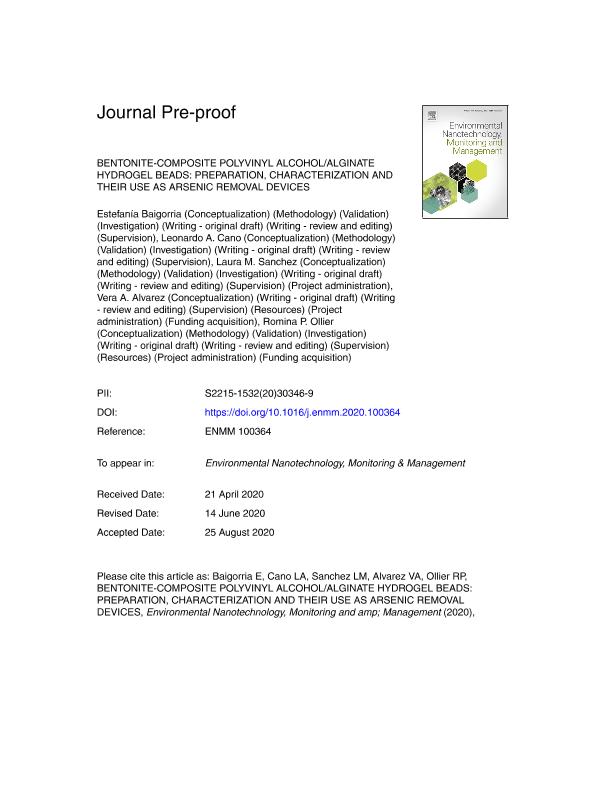Mostrar el registro sencillo del ítem
dc.contributor.author
Baigorria, Estefanía

dc.contributor.author
Cano, Leonardo Andres

dc.contributor.author
Sanchez, Laura Mabel

dc.contributor.author
Alvarez, Vera Alejandra

dc.contributor.author
Ollier Primiano, Romina Paola

dc.date.available
2021-08-06T12:48:02Z
dc.date.issued
2020-12
dc.identifier.citation
Baigorria, Estefanía; Cano, Leonardo Andres; Sanchez, Laura Mabel; Alvarez, Vera Alejandra; Ollier Primiano, Romina Paola; Bentonite-composite polyvinyl alcohol/alginate hydrogel beads: Preparation, characterization and their use as arsenic removal devices; Elsevier; Environmental Nanotechnology, Monitoring and Management; 14; 12-2020; 1-32
dc.identifier.issn
2215-1532
dc.identifier.uri
http://hdl.handle.net/11336/137949
dc.description.abstract
Arsenic (As) is a major source of water contamination that has both natural and anthropogenic origins, so that, to remove it from water is a relevant topic. Taking into account the ease of operation, the cost of processing and the required instrumentation, adsorption processes could be considered as very convenient alternative technologies for water remediation. The present research work is focused on the development and characterization of eco-friendly polyvinyl alcohol (PVA) and alginate (Alg) hydrogel beads containing natural bentonite (Bent) as potential useful devices for As removal from polluted water. Composite beads with different PVA/Alg proportions (75/25 and 50/50) with and without 30 wt.% Bent were prepared by ionic gelation. The obtained beads were thoroughly characterized by means of thermal analysis (differential scanning calorimetry and thermogravimetric analysis), crosslinking degree by evaluating the gel fraction (GF), the capacity of swelling, morphological aspects (by Scanning Electron Microscopy), functional groups and interactions (by FTIR) and finally, the performance of the beads as arsenic adsorbent was tested by treating batch aqueous solutions. Morphological investigations showed that wet beads were highly porous and spherical. Moreover, the beads with the highest PVA content absorbed higher amounts of water whereas the incorporation of clay to the hydrogels produced a reduction on the swelling degree and an increase of GF. The adsorption behavior of the pearls towards As was studied in terms of PVA/Alg ratio, clay loading and contact time. The results clearly demonstrated that the clay inclusion plays a key role in the As removal since unfilled PVA/Alg beads were not able to remove it. The FTIR spectra of beads after As removal show the partial migration of the components of the beads, which can be associated with the intermediate crosslinking degree and almost amorphous state within the matrix.
dc.format
application/pdf
dc.language.iso
eng
dc.publisher
Elsevier

dc.rights
info:eu-repo/semantics/openAccess
dc.rights.uri
https://creativecommons.org/licenses/by-nc-nd/2.5/ar/
dc.subject
ARSENIC
dc.subject
BENTONITE
dc.subject
ENVIRONMENTAL REMEDIATION
dc.subject
HYDROGEL
dc.subject
POLYVINYL ALCOHOL
dc.subject
SODIUM ALGINATE
dc.subject.classification
Compuestos

dc.subject.classification
Ingeniería de los Materiales

dc.subject.classification
INGENIERÍAS Y TECNOLOGÍAS

dc.subject.classification
Físico-Química, Ciencia de los Polímeros, Electroquímica

dc.subject.classification
Ciencias Químicas

dc.subject.classification
CIENCIAS NATURALES Y EXACTAS

dc.title
Bentonite-composite polyvinyl alcohol/alginate hydrogel beads: Preparation, characterization and their use as arsenic removal devices
dc.type
info:eu-repo/semantics/article
dc.type
info:ar-repo/semantics/artículo
dc.type
info:eu-repo/semantics/publishedVersion
dc.date.updated
2021-07-30T18:25:09Z
dc.journal.volume
14
dc.journal.pagination
1-32
dc.journal.pais
Países Bajos

dc.journal.ciudad
Amsterdam
dc.description.fil
Fil: Baigorria, Estefanía. Consejo Nacional de Investigaciones Científicas y Técnicas. Centro Científico Tecnológico Conicet - Mar del Plata. Instituto de Investigaciones en Ciencia y Tecnología de Materiales. Universidad Nacional de Mar del Plata. Facultad de Ingeniería. Instituto de Investigaciones en Ciencia y Tecnología de Materiales; Argentina
dc.description.fil
Fil: Cano, Leonardo Andres. Consejo Nacional de Investigaciones Científicas y Técnicas. Centro Científico Tecnológico Conicet - Mar del Plata. Instituto de Investigaciones en Ciencia y Tecnología de Materiales. Universidad Nacional de Mar del Plata. Facultad de Ingeniería. Instituto de Investigaciones en Ciencia y Tecnología de Materiales; Argentina
dc.description.fil
Fil: Sanchez, Laura Mabel. Consejo Nacional de Investigaciones Científicas y Técnicas. Centro Científico Tecnológico Conicet - Mar del Plata. Instituto de Investigaciones en Ciencia y Tecnología de Materiales. Universidad Nacional de Mar del Plata. Facultad de Ingeniería. Instituto de Investigaciones en Ciencia y Tecnología de Materiales; Argentina
dc.description.fil
Fil: Alvarez, Vera Alejandra. Consejo Nacional de Investigaciones Científicas y Técnicas. Centro Científico Tecnológico Conicet - Mar del Plata. Instituto de Investigaciones en Ciencia y Tecnología de Materiales. Universidad Nacional de Mar del Plata. Facultad de Ingeniería. Instituto de Investigaciones en Ciencia y Tecnología de Materiales; Argentina
dc.description.fil
Fil: Ollier Primiano, Romina Paola. Consejo Nacional de Investigaciones Científicas y Técnicas. Centro Científico Tecnológico Conicet - Mar del Plata. Instituto de Investigaciones en Ciencia y Tecnología de Materiales. Universidad Nacional de Mar del Plata. Facultad de Ingeniería. Instituto de Investigaciones en Ciencia y Tecnología de Materiales; Argentina
dc.journal.title
Environmental Nanotechnology, Monitoring and Management
dc.relation.alternativeid
info:eu-repo/semantics/altIdentifier/doi/https://doi.org/10.1016/j.enmm.2020.100364
dc.relation.alternativeid
info:eu-repo/semantics/altIdentifier/url/https://www.sciencedirect.com/science/article/abs/pii/S2215153220303469?via%3Dihub
Archivos asociados
